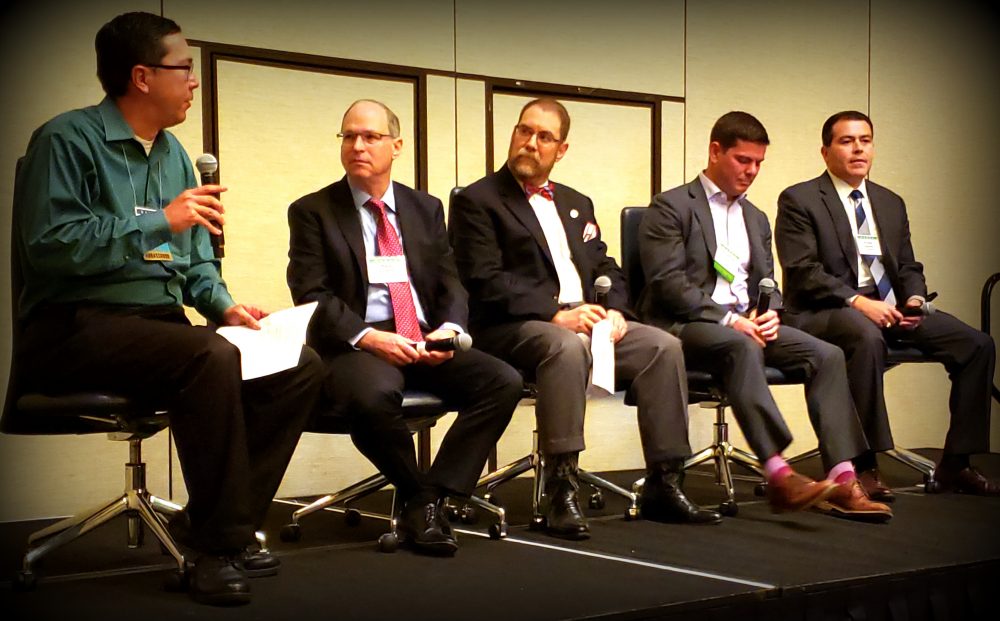Regulators should use their ‘convening’ power to coordinate grid resiliency

SAN ANTONIO – State utility regulators should take a larger role in helping communities prepare for potential disasters and extended power outages by using their strategic position to drive the planning process for energy grid resiliency among the different stakeholders.
Consumers, businesses, and government services are increasingly dependent on readily available energy sources. Regulatory agencies now have a golden opportunity to facilitate planning and cooperation among the growing number of diverse companies and agencies that will play important roles in quickly restoring utilities to cities and states hit by natural disasters or by a potentially devastating cyberattack.
“Use your power as a convener,” Jonathan Monken, senior director of Electricity Infrastructure Policy at PJM Interconnection, said Wednesday. Monken was on a panel discussing the role that public utility commissions should play in enhancing grid resiliency at the National Association of Regulatory Utility Commissioners (NARUC) Annual Meeting and Education Conference this week. He said that with nearly every vital utility service under some form of government oversight, including water, telecommunications, and energy, regulators have the political clout and technical expertise to play a key role in developing an overall disaster plan.
“You have an opportunity to gather together all of the disparate state agencies that don’t necessarily recognize the risk or don’t have the personnel or resources,” Monken said.
Grid resiliency was a major topic of discussion at the NARUC meeting in San Antonio as utilities nationwide grapple with increasingly wild and destructive weather and growing cyber threats from hostile countries. Consultant Paul Stockton, a former Assistant Secretary of Defense for Homeland Defense and Americas’ Security Affairs, told the panel that U.S. intelligence agencies said foreign government hackers had the capability to keep multiple natural gas pipelines – key suppliers of both power-plant fuel and home heating – offline for days or even weeks.
The speakers pointed out that the traditional lead agencies in disaster relief – first responders, state emergency service offices, the Federal Emergency Management Agency (FEMA) – are not involved in grid resiliency, but utility regulators are. They find themselves in a unique position to connect government emergency agencies with the private companies that make up the energy sector. While FEMA and the National Guard will take care of immediate relief efforts, it is up to those companies to restore power to afflicted areas and to also allow other vital services to come back online.
“It’s all about enabling different sectors to support one another in a crisis,” Stockton said. “It’s not FEMA bringing in bags of ice in a crisis; its infrastructure and its owners taking the lead and assisting one another across sectors. It’s also an opportunity for public commissioners to say, ‘How do we get tight with the emergency management community to get ready.’”
Jay Morrison, vice president of Regulatory Affairs for the National Rural Electric Cooperative Association, said it was important for all stakeholders, including smaller and rural utility agencies that might be the home of distant wind farms and high-voltage transmission lines, to be kept in the loop and that state commissions hold regular meetings to update their emergency plan. “We can’t do this on a one-off or ad hoc basis,” he said.
“We are a network system,” Morrison said. “They are all subject to different risks and are managed by different stakeholders and different regulators. If one set of stakeholders or regulators defines their risk as the most important and drives the mandate down, that can hamper the ability of the other stakeholders and regulators to manage the different risks that they face.”
Utility regulators also have the advantage of authority in setting the utility rates that are the bottom-line key to enhancing grid resiliency. Commissioner Jay Balasbas of the Washington Utilities and Transportation Commission said after the session that requests for rate increases to fund resiliency or to pay for service restoration after an emergency would likely still have to grind through the regular hearings and legal filings.
Monken added during the session the price tag for resiliency was not something that could be ignored or simply rubber-stamped in the name of expediency, which makes the deliberative process important to taxpayers and consumers.
“The commission is ideally positioned to bring all of the planets into the same orbit,” said Monken. “We can’t just say, ‘It’s going to be really great, but we really don’t know how much it is going to cost.’”
